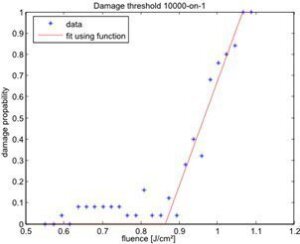
Fig. 1: typical measurement of the damage threshold of a layer system with the S-on-1 (s=10000 in this case) technique
Graphic: Univ. Jena, IAPThe laser induced damage threshold (LIDT) determines the critical fluence, where surfaces of optical components, protection layers or raw materials show permanent and irreversible changes. The knowledge of the LIDT is important for the optical development and is an essential property, when optics for high power lasers are manufactured or used. The measurement of the LIDT is ruled by EU-standards, i.e. ISO 21254:2011 [1].
The LIDT measurement bases on the intentional damage of the samples surface. Therefore light is focused onto the sample to obtain a small spot diameter in the order of 50 µm to obtain high fluences. According to the expected damage threshold the laser pulse energy is varied in a range from no damage to total damage using constant spot size. Taking statistics into account in this energy range one observes a transition from 0% to 100% damage. Linear regression of the damage probability within this range to the 0% value results in the LIDT. Simultaneous monitoring of pulse energy, spot size, pulse duration and number of pulses is performed to obtain reproducible and comparable results of LIDT.
The ultrafast optics group at the IAP operates an automated setup for determination of the LIDT according to ISO standard. The setup is capable to measure the LIDT for the techniques 1-on-1 and S-on-1. In the first case each point on the sample is illuminated with only a single laser pulses (1 pulse on 1 point) and it is detected if the position is destroyed or intact. In contrast if you use the S-on-1 process each point is illuminated with any number S of laser pulses. The flexibility in the samples' adjustment allows for incident angles of the laser light of 0°-45° and the direction of the polarization can be adjusted from s to p. Typical LIDT measurements are performed at 1030 nm with pulse duration as short as 500 fs. However, measurements at other wavelengths and longer pulse durations can be performed, too.
